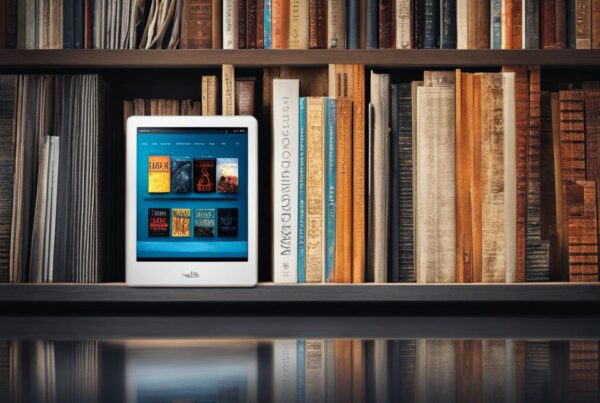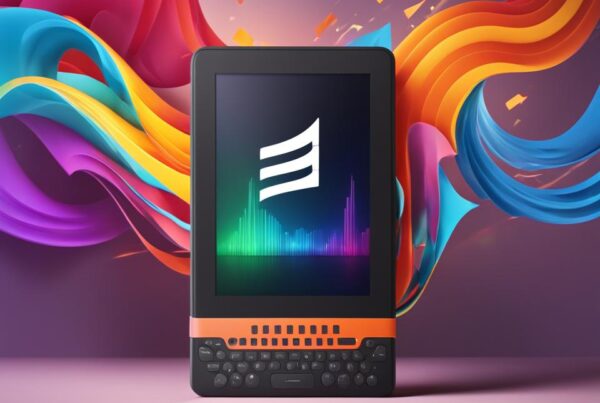As an avid reader and an audiobook enthusiast, I’ve often wondered which one is better: traditional audiobooks or Audible? The debate between audiobooks vs Audible has become quite popular in recent years, and it’s no surprise why. Both options offer a convenient way to enjoy your favorite books on-the-go, but which one comes out on top?
In this article, I will be comparing audiobooks and Audible in terms of convenience, cost, accessibility, user experience, and more. This showdown will help you make an informed decision and determine the best option for your reading needs.
Key Takeaways:
- Audiobooks and Audible are popular options for enjoying books through spoken words.
- The debate between audiobooks vs Audible has become increasingly popular as both offer a convenient way to enjoy books on-the-go.
- We will compare audiobooks and Audible in terms of convenience, cost, accessibility, user experience, and more to determine the better option.
What are Audiobooks?
When it comes to reading books, the traditional way is to sit down, grab a physical copy, and read it. However, in today’s fast-paced world, not everyone has the time or the patience to go through the entire book manually. Enter audiobooks, a convenient way of enjoying books without having to sit down and read them.
Audiobooks are audio recordings of books that allow listeners to enjoy a book’s content through spoken words. These recordings are available in different formats, including CDs, digital downloads, and streaming services.
One of the significant advantages of audiobooks is that you can listen to them while doing other activities like exercising, commuting, or doing household chores. This convenience factor has made audiobooks increasingly popular over the years, and the industry has grown significantly.
According to a report by the Audio Publishers Association, audiobook sales have increased by 12% in 2020, generating $1.3 billion in revenue.
Whether you’re a busy professional or simply enjoy multitasking, audiobooks provide a convenient solution to incorporate reading into your lifestyle.
Introducing Audible
Before we compare audiobooks to Audible, let’s take a closer look at this popular platform.
Audible is a digital audiobook service that offers a vast library of audiobooks for purchase or subscription. It was founded in 1995 by Don Katz and was acquired by Amazon in 2008.
With Audible, you can purchase individual audiobooks or subscribe to their monthly or annual membership plans. Membership plans offer a free credit each month, which can be redeemed for an audiobook of your choice. Audible also offers a free trial to new members.
Audible has several features that make it a popular choice for audiobook listeners. The platform provides a user-friendly interface, easy navigation, and personalization options to tailor your listening experience. It also offers a feature called Whispersync, which allows users to switch between reading the ebook version and listening to the audiobook version of the same title, seamlessly picking up where you left off.
Overall, Audible has a lot to offer for audiobook enthusiasts, making it a tough competitor for other audiobook options.
Convenience Comparison
When it comes to convenience, both audiobooks and Audible have their pros and cons. Audiobooks are typically available in various formats, including CDs or digital files, making them compatible with a range of devices. You can listen to them on your phone, tablet, laptop, or even your car’s audio system.
On the other hand, Audible offers a more streamlined experience. With the Audible app, you can easily access your audiobooks from one central location, eliminating the need to keep track of multiple files. Additionally, you can download audiobooks for offline listening, which is particularly useful if you’re on a road trip or don’t have access to Wi-Fi.
That being said, the convenience of audiobooks vs Audible may ultimately come down to personal preference. Audiobook fans may prefer the flexibility and freedom to listen to their books on various devices, while Audible users may find the app’s interface and organizational features more convenient.
‘As a busy mom, I love how I can always have an audiobook playing in my car while running errands. With Audible, I can easily switch between books and pick up right where I left off.’
Overall, when it comes to convenience, both audiobooks and Audible have their strengths and weaknesses. It’s important to consider your lifestyle and preferences when deciding which option works best for you.
Cost Considerations
When it comes to deciding between audiobooks and Audible, cost is a significant factor to consider. Audiobooks can be relatively expensive, especially if purchasing from popular retailers such as Amazon or iTunes. On the other hand, Audible has different pricing models that offer a more cost-effective option for avid listeners.
Audible offers a monthly subscription service, which allows access to a vast library of audiobooks at a more affordable price. Additionally, subscribers can receive discounts on audiobook purchases that are not included in the subscription. Audiobooks purchased through Audible are also cheaper compared to their physical counterparts.
While audiobooks may appear to be a more economical option, particularly for individuals who do not listen to audiobooks frequently, Audible’s subscription model offers great value for avid listeners. Its membership provides access to audiobooks that would otherwise cost substantially more if purchased individually.
Accessibility Features
Accessibility features are crucial when it comes to audiobooks and Audible. They enable people with disabilities to access and enjoy audiobooks conveniently. Audiobooks are generally accessible because they convert written text into spoken words, allowing people with visual impairments or reading difficulties to access content.
However, Audible goes a step further by providing additional accessibility features. For instance, Audible has a partnership with the National Association of Blind Merchants (NABM) to provide free subscriptions to visually impaired people. Moreover, Audible has developed an app for people with dyslexia, making the platform more inclusive.
“As someone with visual impairment, I find Audible’s accessibility features to be a game-changer. The app allows me to adjust playback speed, which helps me read faster than usual. I am also grateful for the NABM partnership, which enables me to access my favorite books conveniently.”
Audiobooks are also accessible, but the accessibility features available are limited compared to those of Audible. Additionally, the cost of audiobooks may be prohibitive for some users, making Audible more accessible.
User Experience: Enhancing Enjoyment of Audiobooks and Audible
As a self-proclaimed audiobook enthusiast, I understand the importance of user experience in enhancing the enjoyment of these literary gems.
Audiobooks and Audible offer different interfaces and features that may affect the overall user experience. Audiobooks typically come in the form of downloadable files, which can be played on various devices. On the other hand, Audible has its app that often provides a more seamless user experience.
Personalization options are also essential in improving user experience. Audiobooks can come with different narration styles, allowing the listener to choose a voice that they find most appealing. Audible, on the other hand, provides users with the option to adjust the narration speed, set bookmarks, and create customized playlists.
Additional features like sleep mode, which pauses the audiobook after a certain period, can prevent users from losing their place or missing important parts of the story due to dozing off.
“Audiobook listeners generally have longer attention spans and better reading comprehension, making audiobooks an excellent option for individuals who find it challenging to concentrate on lengthy texts.”
While audiobooks offer the flexibility of choosing various sources of audio content, Audible, with its extensive library, offers a more focused and streamlined experience. Audible has its original content exclusive to their platform, and with the Audible membership, users have access to premium content that is not available elsewhere.
Overall, user experience is a crucial factor in determining which option- audiobooks or Audible- is superior. While audiobooks offer the flexibility of choosing different sources of audio content, Audible provides a more seamless and personalized user experience.

Conclusion
After comparing audiobooks vs Audible, it is clear that both options have their pros and cons. Audiobooks are convenient in that they can be borrowed from the library or purchased from various sources, while Audible offers a vast library and subscription options for a seamless listening experience.
In terms of cost, audiobooks can be more cost-effective for infrequent listeners, while Audible’s subscription model can provide significant savings for avid listeners.
Accessibility features are also important considerations, and both options offer options for individuals with visual impairments or reading difficulties.
When it comes to user experience, Audible’s interface and personalization options make it an attractive choice.
My Verdict:
Overall, it ultimately comes down to personal preferences and usage patterns. For those who only occasionally listen to audiobooks, traditional audiobooks may be the better choice. However, for avid listeners who want a seamless listening experience and a wide range of options, Audible may be the way to go.
In conclusion, audiobooks vs Audible is not a clear-cut battle. It depends on your needs and preferences. So, the final verdict is for you to decide.



